NYFF 2012 Preview: ScreenAnarchy Raises The Curtain With 14 Capsule Reviews
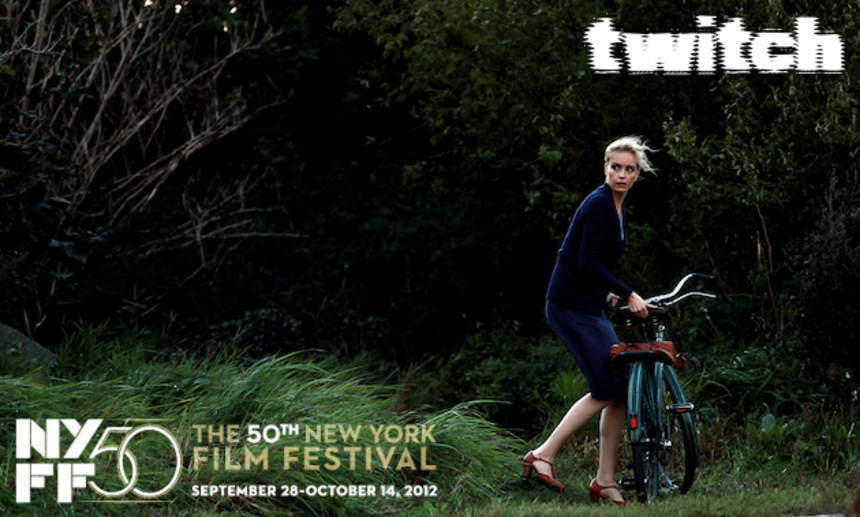
 PASSION
PASSIONTired of the "grindhouse meets arthouse" cliché? Well, in honor of Passion I'd like to propose a variation--"grindhouse meets grad school." That's because Brian De Palma's latest features both his '70s-'80s lurid-thriller trademarks--bird's-eye shots of spiraling stairs! split screens! wigs and masks! giallo-style kills!--and enough meta-commentary on the female image to launch a film studies MA all by itself. In fact, it's just this combo of over-familiarity and self-consciousness that is apt to put off certain audience segments. As for me, I found it all terrific, if incessantly preposterous, fun. Rachel McAdams vamps things up beyond believability, beyond camp, and into some brand-new previously uncharted territory; meanwhile Noomi Rapace pouts adorably as her co-star schemes in a way that aspires to All About Eve but ends up with something closer to high school operatics. Most intriguingly, De Palma's direction of both leads seems to reflect an intention of, "No, remember, we don't want good, we want entertaining." So if you're expecting a nuanced, femme-centric chiller à la Chabrol... um, sorry. Maybe that describes the source text, Corneau's Love Crime, but I haven't seen it--a situation I'm now motivated to correct. (Sep.29, Oct 6, 11) - Peter Gutierrez
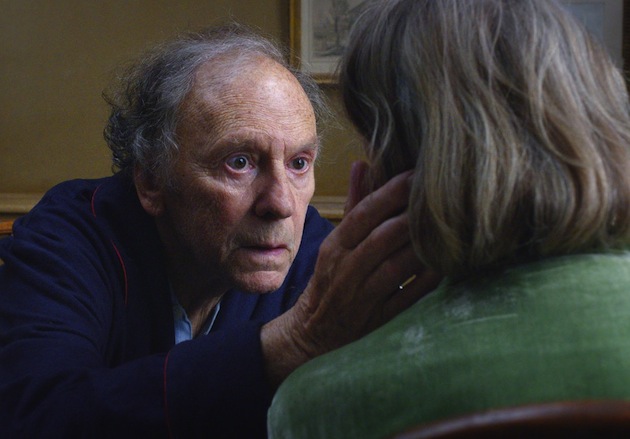 AMOUR
AMOURGetting old is an ugly business and seldom a subject for cinema. I can't think of anyone more fitting than Michael Haneke to tackle this uncinematic, almost taboo subject. Amour is a somber and completely unsentimental depiction of a slow, agonizing death of a loved one. An old Parisian couple Georges (Jean-Louis Trintignant) an Anne (Emmanuelle Riva) are first seen at a piano concert among the audience. They are retired music teachers, attending one of their successful pupils' piano recitals. They start as audiences then quickly become our subjects. A stroke leaves Anne half paralyzed and wheelchair bound and her health steadily declines. Before Anne loses her marbles, the couple serenely talks about their imminent future. She doesn't wish to go back to the hospital ever again. Georges obliges. As her conditions worsen, devoted Georges takes care of his wife 24/7, despite emotional protests from their daughter (Isabelle Huppert). Dying is a grisly, undignified, degrading affair where no one is to blame. Georges is old enough to know this. But the question is this: how much can you take the suffering of your loved one? Just like Haneke's other films, Amour is not a film to be enjoyed. Watching it makes you uncomfortable and sad- much sadder than his other films even. It's very straightforward and direct. Shot economically and with no visual flares by Darius Khondji (in their second collaboration), its cinematography takes a backseat to immense performances by the two principals. Riva gives, hands down, the best performance of the year. In her graceful face, you see the remnants of that beauty from Hiroshima Mon Amour- it makes the whole experience all the more devastating. Trintignant too is amazing. There is no music to guide us emotionally, even though they are pianists. It starts and ends in silence. In typical Haneke fashion, watching Amour, you don't get overly emotional, rather, you feel numb. It certainly deserves all the recent accolades. (Oct. 5, 6) - Dustin Chang
 THE BAY
THE BAYFound footage horror movies are still a thing? I kind of tuned out after Paranormal Activity. I hear-tell we'll be seeing part four of that franchise come October, which is crazy. Didn't the first installment only come out last year? It seems producer/writer/director Oren Peli has had a hand in nothing but producing/writing/directing these types of films since he burst onto the scene.
And hey, guess what? He's listed as a producer on Barry Levinson's new ecological found footager, The Bay. I guess he's playing to his strengths. And The Bay is actually pretty strong, although I attribute that more to the direction of a veteran helmer like Levinson (who comes from outside the genre), as well as a tight script that weaves together multiple storylines. This tale of egregious pollution begetting killer isopods is very effective, partly due to the plausibility of the whole thing. (If you don't believe me, Google 'giant isopods' and prepare for the willies.) That being said, I never need to see another found footage horror movie again. (Sep. 29, 30) - Joshua Chaplinksy
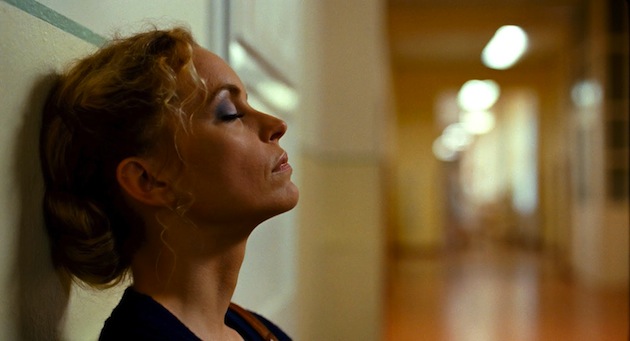 BARBARA
BARBARAChristian Petzold evokes the stark landscape of the police state of 1980 East Germany in Barbara, which, among its other virtues, is a great vehicle for the often astonishing Nina Hoss, appearing for the fifth time in a Petzold film, delivering one of her very best performances. Here she essays the title character, a doctor punished for applying for an exit visa by being sent to a pediatric hospital in the middle of nowhere, under constant surveillance (and periodic house and body cavity searches) by the authorities. Barbara can trust no one, even her colleague Andre (Ronald Zehrfeld), who seems to have taken a romantic interest in her. The stakes here are especially high, since she continues to surreptitiously arrange for escape with her lover out of the GDR. Stella (Jasna Fritzi Bauer), a young patient admitted from a hard labor camp, complicates matters and forces Barbara to reconsider her plans. Petzold goes far beyond merely condemning a repressive regime; he gives us the inside view of how such a system twists the psyches of all who suffer under it, making people mistrust every aspect of human behavior, however seemingly benevolent and innocent on the surface. (Oct. 1, 6) - Christopher Bourne
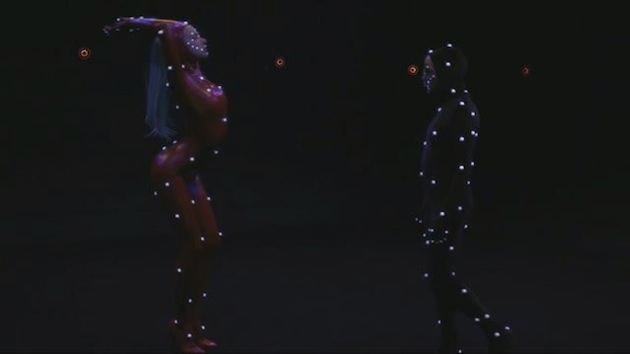 HOLY MOTORS
HOLY MOTORSI'm pretty sure I won't see anything more audacious this year than Leos Carax's self reflexive, funny, goofy and touching ode to cinema. Holy Motors follows Alex the performer (Carax's alter ego played by Denis Lavant) as he goes through 9 different lives in one night. The film makes full use of Lavant's acrobatic skills- especially in 'the motion capture' segment that highlights the actor's physical agility and pays a tribute (on a treadmill) to his own film, Mauvais Sang. It also features some of the most bizarre casting choices- aside from Lavant, Michel Piccoli, Edith Scob, it also stars Eva Mendes and Kylie Minogue. Carax retraces his steps onto the Pont-neuf even, ever so slightly: after 20 years, old lovers Jean (Minogue) and Alex meet at empty Le Samaritaine department store overlooking the famed bridge which was the setting for Carax's magnum opus (and my personal favorite) Lovers on the Bridge (1991).
Holy Motors marks a comeback of a major French auteur (his last feature was Pola X in 1999). It was very disconcerting to see him all broken up and bitter at a Q&A session for an omnibus film, Tokyo!, in which his contribution Merde was definitely the highlight of the three. He was having a hard time financing any of his projects. He talked about his desire to use his character Merde (Lavant)- a flower eating, deformed creature living in the Tokyo sewer, again in some other occasions and I'm glad he gets to do that in this film. Holy Motors is a product of a frustrated artist finding ways to express himself under difficult financial circumstances. Its disjointed, episodic narrative reflects that. It's vastly different from his earlier work but just as mesmerizing nonetheless. And how can anyone get tired of watching Denis Lavant on screen? He is in top form in this. (Oct. 11) - DC
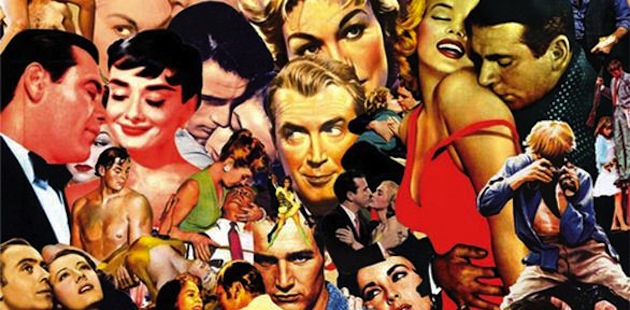 FINAL CUT - LADIES AND GENTLEMEN
FINAL CUT - LADIES AND GENTLEMENMost movie-lovers will appreciate a well-made "Super-Cut"-style mashup of great films when one surfaces as a fannish video on YouTube, as a festival trailer, or as a year-end wrap-up. After all, when the edits are smooth, and the material is stellar, both in content and source quality, what's not to like? Add some startling or humorous juxtapositions of clips, and you've got a winner on your hands. That said, would you want to watch 80+ minutes of such a cinematic highlight reel? If your answer is yes, then György Pàlfi's heartfelt, though feature-length, montage sequence is a solid NYFF bet for you. (If you're fond of Rashomon, David Lynch, Tarantino, Taxi Driver, and great musical scores, so much the better.)
But one caveat: the intentionally simplistic "Boy Meets Girl" narrative that Pàlfi has grafted onto things ultimately doesn't take the audience anywhere truly new or unexpected. Granted, it's not entirely trying to, but I was still disappointed that it didn't follow up on some of its own promising leads. For example, though Rosemary's Baby is featured several times, we never get the expected childhood-oriented segment despite nearly every other facet of human existence getting its share of screen time. (Oct. 1) - PG
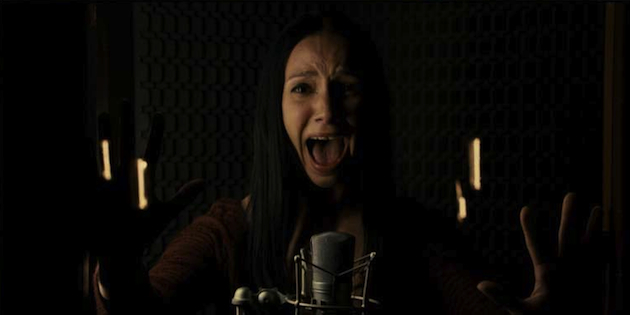 BERBERIAN SOUND STUDIO
BERBERIAN SOUND STUDIOThe second feature from British director Peter Strickland, Berberian Sound Studio has a simple enough premise. A prominent sound designer known for his work in nature documentaries somehow winds up working on a horror film in Italy.
The film (BBS, not the film within the film) is being billed as an homage of sorts to the Italian giallo of the 70s and 80s. The giallo is one of those genres, like exploitation and much of horror, in which quality rarely measures up to notoriety. I've personally never seen a giallo that was greater than the sum of its nudity and violence, so it's odd that the best "giallo" I've ever seen has little to none of either, and doesn't really resemble that which it pays tribute to. It's more a mix of 70's DePalma and Lynchian weirdness. And once I realized this, about 40 minutes into the film with no clear inciting incident in sight, I really began to enjoy myself. I'm sure some will complain about the lack of traditional narrative structure, but they get so many films for "them", so I'm claiming this one for "us". A very cool mind-bender with grade A acting (especially from Toby Jones, the other Capote) and fantastic sound design. (Oct. 5, 9) - JC
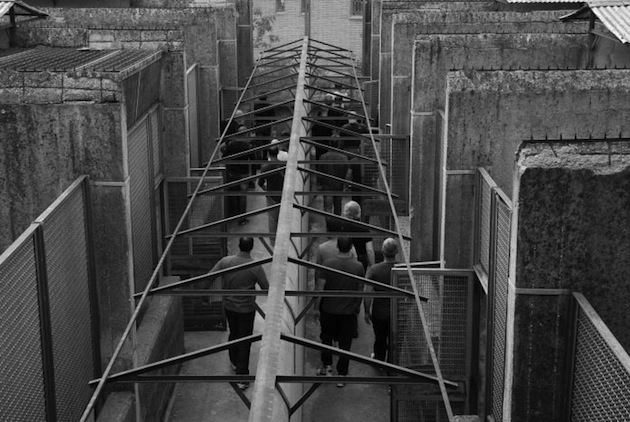 CAESAR MUST DIE
CAESAR MUST DIETwo years ago I sat through another Shakespeare adaptation at NYFF, Julie Taymor's The Tempest, and tried to persuade myself into feeling entertained. This seemed to be my polite duty since the film, for its part, was so aggressively trying to dazzle me. As one might expect upon learning that the Taviani Brothers' quasi-adaptation of Julius Caesar is set in a real prison and features real inmates as its cast, the intent here is nearly the opposite: not that there aren't plenty of memorable moments of humor, surprise, fury, and deep sorrow, but rather that these occur without straining for even a second. Shot mostly in black-and-white and making the most of the inevitably austere prison setting (which, odd though it may sound, is strikingly beautiful), Caesar Must Die relies on its heartfelt, and unexpectedly accomplished, performances and the sheer power of Shakespeare's narrative. Although it certainly helps if you're familiar with the play, this version is made accessible via its vernacular-heavy language, and how the story itself progresses via distilled snippets of drama--hence my "quasi-" earlier. No, the Taviani's aren't trying to be radical, but instead demonstrate how enduring art can be radical all by itself. ( Sep. 29, 30, Oct. 1, 8) - PG
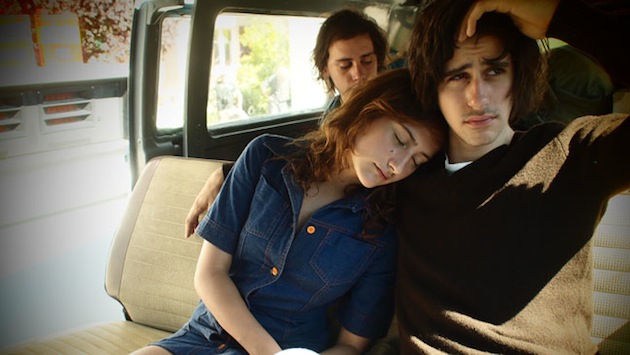 SOMETHING IN THE AIR
SOMETHING IN THE AIR The French title (Apres Mai) refers to the student uprising and General Strike of May 68. Something in the Air starts with a group of High School students' violent confrontation with baton wielding, teargas shooting cops on motorcycles. The scene is too energetic and immediate to be nostalgic. Set in 1971, this semi-autobiographical, ensemble piece about a group of students in tumultuous times when everything seemed possible, is at once personal and sprawling. After vandalizing their school with revolutionary banners and graffiti, they end up hurting one of the security guards and are told to lay low during the summer. Puppy eyed, mild mannered aspiring painter Gilles (newcomer Clément Métayer) who just broke up with his ethereal poetess girlfriend (Carole Combes), hitches a ride with the Leftist filmmakers, along with a devout of the cause, Christine (Lola Créton) and artistically inclined Alain (Félix Armand) to Italy. Along with attention to periodical detail (from music to costumes and all the cultural/political references), Assayas's careful and tender characterizations of these clear-eyed young people are well balanced and truthful. Their youthful energy and sense of wonder is quite infectious. One can't help but compare them to the disaffected, docile youth of today. (Oct 5, 8, 12) - DC
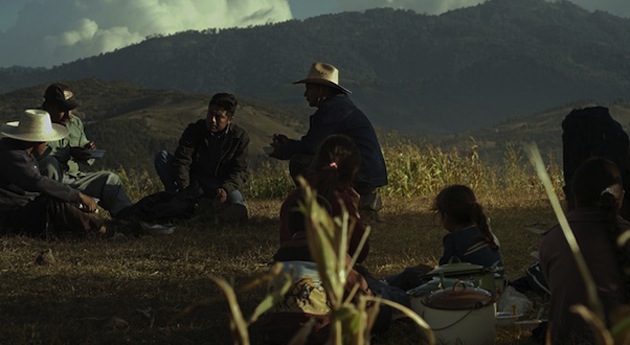 HERE AND THERE
HERE AND THEREImmigration between Mexico and the US is a perennial political hot potato, never more so than in a presidential election year such as this. But the rhetorical bromides proffered on all sides of the issue often give short shrift to the human element, many aspects of which refuse to be placed into neat ideological boxes. A change in the usual perspective offers wonderful possibilities to rethink our (mis)conceptions, and this idea is given artistically beautiful form in Spanish director Esparza's Mexico-set debut feature Here and There. "Here" and "there" are adverbs whose meanings change drastically depending on one's vantage point, and Esparza tells his story on the aftereffects of immigration and repatriation from an angle we rarely see: that of the Mexican immigrant returning to his home country. "Here," in this case, is the home in Mexico that Pedro (Pedro de los Santos) returns to after two years in the U.S., facing a still loving wife and two often distant daughters (especially the eldest), who haven't gotten to know their father that well, their emotional ties threatened by his absence. Pedro attempts to put a band together to perform at parties in the areas surrounding his hometown. But increasingly difficult financial realities force Pedro to contemplate going back "there," that is, the U.S., once again. Esparza weaves documentary elements - his nonprofessional lead actor is an actual musician, and his wife in real life plays his wife in the film - with an understated yet quietly lyrical visual style that lends a bracing dynamism and a sense of the community that surrounds its main characters. Here and There is one of the true discoveries of this year's NYFF, and one of my personal favorites. (Sept. 29, Oct. 2) - CB
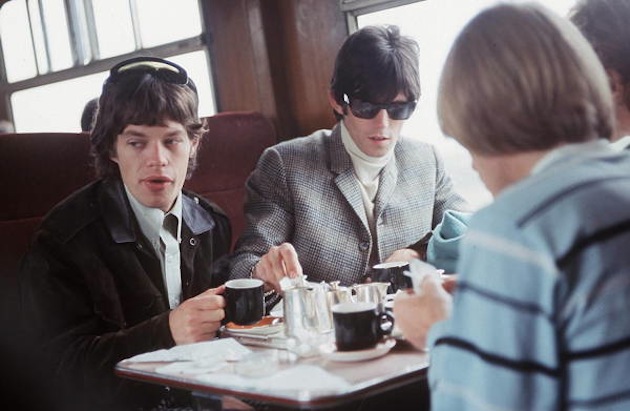 THE ROLLING STONES - CHARLIE IS MY DARLING - IRELAND '65
THE ROLLING STONES - CHARLIE IS MY DARLING - IRELAND '65 If, like me, you are a sucker for a good doc and are a student of rock n' roll history, then TRS-CIMD-I65 is a must see. (That's right, you're not getting me to type out the full title more than once.) The film is actually a re-edited restoration of Charlie Is My Darling, Peter Whitehead's portrait of a young band on the cusp of superstardom. It includes vintage performance footage of The Stones in Ireland-- most notably an amazing moment where the crowd bum-rushes the stage, attacks the band, and starts playing their instruments-- as well as footage of off-stage downtime, in which the band is never far from a catchy tune. There are also candid interviews with the band, as they try to wrap their minds around their sudden fame and ponder what the future holds. A great time capsule-- especially compared with where the band is now-- that makes you long for the days when rock n' roll was actually dangerous and not a stylistic affectation. (Sep 29, Oct. 3) - JC
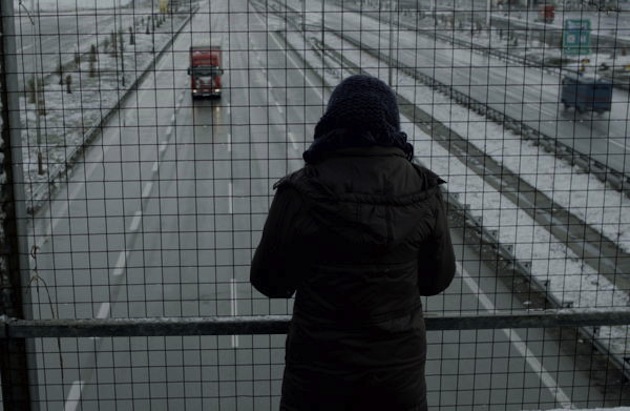 ARAF
ARAF"Araf" is the Turkish word for purgatory or limbo, and this is an apt description of the quality of life for many of the characters we see in Yesim Ustaoglu's latest feature. Araf is set in the area around a truck stop that serves the highway connecting Ankara to Istanbul. The two young people at its center - Zehra (Neslihan Atagul), an 18 year-old woman who works at a cafeteria in the truck stop; and Olgun (Baris Hacihan), a young man who is her co-worker and wannabe boyfriend - long to escape from their drab circumstances. In this vast economic and physical wasteland, in which thick mist, snow, and rain are the constant weather patterns, they look to escape through TV, especially cheesy reality and game shows. Olgun actively pursues his dream of winning lots of money on the Turkish version of "Deal or No Deal," for example. Soon Zehra finds another potential avenue for egress from her depressing family and work life through Mahur (Ozcan Deniz), a truck driver she meets at a wedding party. However, Zehra herself may be being used as a temporary stop for this considerably older man. Zehra's love-struck emotional state later leads her to a desperate action depicted in a graphic scene that will be tough for some viewers. Ustaoglu's keen eye for connecting universal human drives and emotions with specific Turkish sociopolitical realities, as well as the wonderful performers she has gathered together, make this a potent slice of modern neo-realism. (Oct. 4, 13) - CB
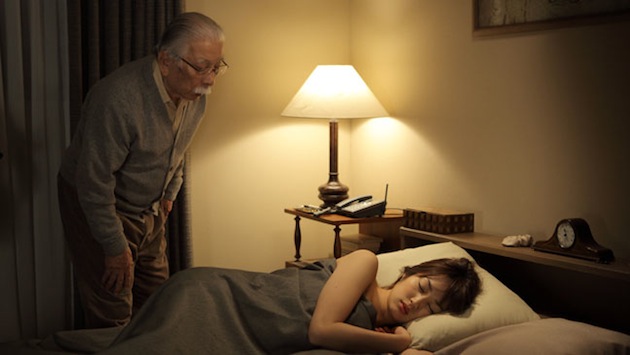 LIKE SOMEONE IN LOVE
LIKE SOMEONE IN LOVEThe premise is pretty simple: a pretty young Japanese college student doubling as a call girl ( Takanashi Rin) meets an elderly professor (Okuno Tadashi) who takes a protective role in her life. But like Abbas Kiarostami's other films, Like Someone in Love ends in quite a different place than where it starts. This Japan set, Japanese language film is still a deliciously challenging experiment in human connections. Many scenes are seen through the windows and the dialog spoken off frame or on the phone. The characters are more frank about their secrets with total strangers than with their own families. And there are many clues that suggest the cyclical nature of love that many Kiarostami fans will mull over and write essays about. Yet, Like Someone in Love is not as masterful as his Italy set Certified Copy. The ending is, however justifiably warranted, too abrupt, its 24-hour timeline too short and the premise too cliché and distracting, it doesn't come close to greatness of his other work. (Oct. 4, 8) - DC
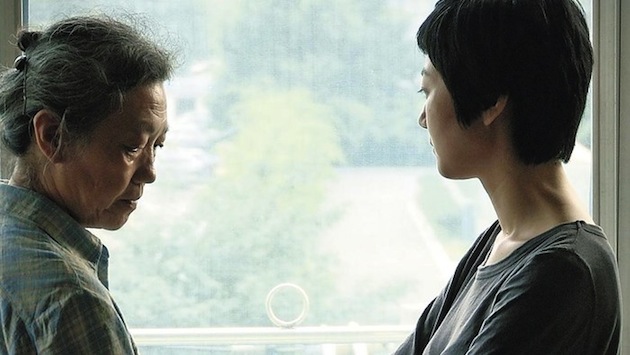 MEMORIES LOOK AT ME
MEMORIES LOOK AT MEA lovely and poignant examination of the weight the past places on the present is offered in Fang Song's often sublime feature debut. Some may remember Song as the film student nanny for Juliette Binoche in Hou Hsiao-hsien's 2007 film Flight of the Red Balloon, and here she shows great potential for someday being as equally accomplished an artist as the Taiwanese master. A small film in its setting (a tiny apartment in Nanjing) but by no means small in its artistry and emotion, Memories Look at Me regards with patient observation what happens when Fang (played by Song herself) travels from Beijing to visit her parents (played by Song's real parents) in Nanjing. This film mostly takes place in Fang's parents' apartment, and consists mostly of conversations between Fang, her parents, and visits from and to extended family members. Song's framing, editing juxtapositions, and the rich sound design suggesting a much vaster world than the enclosed spaces of its scenes, is continually surprising and often breathtaking in its elegant, emotionally charged construction. Many events in the film occur off-screen, existing for us solely in the stories people tell each other about them. There are tears, heartbreak, and painful memories movingly expressed, but there is humor as well: an attempt to set up Fang on a blind date; Fang and her mother's encounter with a feisty hen. Those with some basic knowledge of Chinese history can read between the lines of these conversations, as well as understand the historical significance of its setting of Nanjing. Fang's parents are of the generation that came of age during China's Cultural Revolution, an unspoken subtext to the stories of harsh family circumstances that several elder characters relate in the film. Memories Look at Me is a home movie and a family movie in the best sense of each term: it affirms the value of both home and family as repositories for memory as well as places for nurturing, emotional sanctuary. (Oct. 7) - CB
And there you have it! For now... Keep an eye out for fresh content from Dustin and Christopher in the coming weeks -- including some rather choice (and super-secret) interviews... Ooooh? Ooooh. In the meantime, head on over to the NYFF home page for more on these, and all the films playing this year's fest.

Do you feel this content is inappropriate or infringes upon your rights? Click here to report it, or see our DMCA policy.





